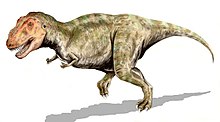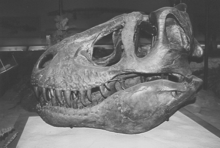Tyrannosaurus
Tyrannosaurus (Latinization from Ancient Greek τύραννος týrannos or Latin tyrannus ["king, despot"] and σαῦρος sauros ["lizard"]) is a genus of bipedal, carnivorous dinosaur in the group Theropoda.
The only generally recognized species is Tyrannosaurus rex, often abbreviated to T. rex, colloquially T-rex. This species is a staple of popular culture as the best-known dinosaur. However, some paleontologists consider Tarbosaurus bataar from Asia to be a second species. Several other genera of North American tyrannosaurids have also been described as synonyms of Tyrannosaurus.
Fossils of Tyrannosaurus have been found in various rock formations in western North America dating to the last three million years of the Cretaceous period, about 68 to 66 million years ago (late Maastrichtian). Tyrannosaurus was thus among the last non-bird dinosaurs to exist until the Cretaceous-Tertiary mass extinction.
Like other tyrannosaurids, Tyrannosaurus was a bipedal (two-legged) carnivore with a massive skull balanced by a long, heavy tail. Relative to its long and powerful hind legs, Tyrannosaurus rex's arms were small but unusually strong for its size. They displayed only two fingers, although a possible vestigial (receded) third finger has been reported. Measuring up to 13 metres long, with a waist height of four metres and weighing up to 9 tonnes, it was the largest known tyrannosaurid and one of the largest land-dwelling carnivores ever, although several other theropods were of similar size or even larger. By far the largest carnivore in its habitat, Tyrannosaurus may have been at the top of the food chain as an apex predator, hunting hadrosaurs and ceratopsians; however, some experts suggest that it was primarily a scavenger.
So far, more than 30 specimens of Tyrannosaurus have been identified, including some nearly complete skeletons. Soft tissue and proteins have been described from at least one of these finds. The comparatively numerous finds have allowed studies of the biology of this animal, including individual development and biomechanics. Also under discussion are the feeding habits, physiology, and possible speed of Tyrannosaurus. The total number of all specimens that have ever lived is estimated at 2.5 billion.
Features
Tyrannosaurus was one of the largest land-dwelling carnivores of all time. The largest and heaviest known specimen is the Canadian find "Scotty" (catalog number RSM P2523.8), which reached dimensions of a good 13 meters and a weight of nearly 9 tons. The find thus surpasses the largest nearly complete specimen to date, "Sue" (catalog number FMNH PR2081), which measures between 12.29 and 12.4 meters in length and has a waist height of 4 meters. Weight estimates from various scientists vary considerably, ranging from less than 4.5 to over 7.2 tons, with the most recent estimates ranging from 5.4 to 6.8 tons. However, a new method measured the volume of some individuals and resulted in a minimum of 9.5 tons for "Sue". Greg Paul estimates "Sue" at 6.1 t.
Tyrannosaurus rex was larger than the well known Allosaurus from the Upper Jurassic and slightly smaller than Spinosaurus from the Early Upper Cretaceous. Its weight exceeded that of all other terrestrial theropods - only Spinosaurus could have reached a similar weight.
Tyrannosaurus' "S"-shaped curved neck was short and muscular to support its heavy head. The legs were among the longest of any theropod relative to the body, contrasting with the tiny but powerful arms. It was long thought that the arms possessed only two fingers - however, an as yet unpublished report describes a third, vestigial finger. The tail was heavy and long to balance the massive torso and head, sometimes displaying over forty vertebrae. To compensate for the animal's enormous mass, many bones were hollow.
The largest known Tyrannosaurus skulls were up to 1.5 meters long. Unlike the skulls of other non-tyrannosauroid theropods, the back of the skull was extremely broad, while the snout was narrow. This adaptation caused the eyes to be more forward, which allowed for unusually good spatial vision. The bones of the skull were massive and some bones, such as the paired nasal bone, were fused, stabilizing the skull. However, many bones were pneumatic, showing cavities that made the bones more flexible but also lighter. These and other features that strengthened the skull were part of a trend within tyrannosauroids that led to an increasingly powerful bite that far surpassed other non-tyrannosaurids. The maxillae were arranged in a "U" shape when viewed from above, rather than a "V" shape as in most other non-tyrannosauroid theropods. While this increased the amount of tissue a tyrannosaur could rip out of prey with one bite, it also increased the stress on the front teeth.
The teeth of Tyrannosaurus and other tyrannosauroids showed heterodonty (differences in shape). For example, the teeth of the premaxilla were tightly packed at the anterior end of the maxilla, were "D"-shaped in cross-section, had reinforcing ridges on the posterior side, were incisiform (the tips were chisel-like in shape), and curved posteriorly. The "D"-shaped cross-section, reinforcing ridges, and posterior curvature reduced the risk of the teeth buckling during biting. The remaining teeth were robust, banana-shaped, and more spaced apart; they also had reinforcing ridges. The maxillary teeth were larger than the mandibular teeth, except for the teeth at the posterior end of the mandible. The largest tooth found is estimated to be 30 cm long, including the root of the tooth; this makes it the largest tooth yet known from a carnivorous dinosaur.

Size comparison of selected large heropods, Tyrannosaurus rex is shown in green (far right)

Different specimens of Tyrannosaurus rex compared with a human being

Live reconstruction
Systematics
Tyrannosaurus is the type genus of the superfamily Tyrannosauroidea, the family Tyrannosauridae, and the subfamily Tyrannosaurinae - in other words, it is the standard by which paleontologists decide whether to place other species in the same group. Other members of the subfamily Tyrannosaurinae include the North American Daspletosaurus and the Asian Tarbosaurus, both of which have been considered synonyms of Tyrannosaurus by some researchers in the past. Tyrannosaurids were once thought to be the descendants of earlier groups of large theropods, such as the megalosaurs and the carnosaurs. Today they are classified within the Coelurosauria, whose members were mostly characterized by small body size.
In 1955, Soviet paleontologist Evgeny Maleev named a new species, Tyrannosaurus bataar, which was discovered in Mongolia. In 1965, it was renamed Tarbosaurus bataar, giving it its own genus. Despite this renaming, many phylogenetic analyses concluded that Tarbosaurus bataar was the sister taxon of Tyrannosaurus rex, which is why it was often listed as an Asian species of Tyrannosaurus. However, a redescription of the skull of Tarbosaurus bataar showed that it was much narrower than that of Tyrannosaurus rex and that forces were distributed quite differently among the bones of the skull during a bite. The distribution of forces in the skull of Tarbosaurus bataar was much more similar to that of Alioramus, another Asian tyrannosaur. A cladistic analysis concluded that Alioramus, and not Tyrannosaurus, was the sister taxon of Tarbosaurus-if this can be confirmed, it would mean that Tarbosaurus and Tyrannosaurus should be kept separate.
Other tyrannosaurid remains found in the same geological formations as Tyrannosaurus rex were originally considered separate taxa - these include Aublysodon and Albertosaurus megagracilis, the latter of which was renamed Dinotyrannus megagracilis in 1995. Today, these finds are listed as juvenile specimens of Tyrannosaurus rex.
Nanotyrannus
→ Main article: Nanotyrannus
A skull discovered in Montana, only 60 cm long, was originally described by Charles W. Gilmore in 1946 as Gorgosaurus lancensis, but was later assigned to a new genus, Nanotyrannus. In 2001, a group of researchers from the Burpee Museum of Natural History discovered another 50% preserved skeleton, nicknamed "Jane" (catalog number BMRP 2002.4.1.). Opinions are divided regarding the validity of N. lancensis. Many paleontologists attribute the finds to a juvenile T. rex. A 2020 study published in Science Advances supports this assumption: a detailed analysis of bone cross-sections of juvenile Tyrannosaurus suggests that Tyrannosaurus growth rates varied with age and that the species appeared to slow their growth when food was scarce, which may have given them an evolutionary advantage. Some of the bones of Nanotyrannus examined in this way confirmed that they were indeed juveniles. So Nanotyrannus was either larger than previously thought, or - which the researchers think is much more likely - the fossils belong to young Tyrannosaurus. Accordingly, the taxon Nanotyrannus is probably invalid; meanwhile, considering Nanotyrannus as a juvenile synonym of Tyrannosaurus is largely scientific consensus.
Manospondylus
The first find that can be attributed to Tyrannosaurus rex consists of two partial vertebrae (one of which has been lost) found by Edward Drinker Cope in 1892 and described as Manospondylus gigas. Osborn recognized the similarity between M. gigas and T. rex as early as 1917, but could not declare the two genera identical because the Manospondylus vertebrae were too fragmentary.
In June 2000, the Black Hills Institute located the site of M. gigas in South Dakota and unearthed additional tyrannosaur bones. These were described as further remains of the same individual and were recognized as identical to Tyrannosaurus rex. According to the International Rules of Zoological Nomenclature (ICZN), which governs the naming of animals internationally, Manospondylus gigas should have priority over Tyrannosaurus rex because it was named before T. rex. However, the fourth edition of the ICZN, which became effective on January 1, 2000, states that the predominant name must be retained if the previously named synonym has not been used as a valid name since 1899 and the subsequently named synonym has been listed as a valid name in at least 25 papers published by at least ten authors in the preceding 50 years. Tyrannosaurus rex meets these conditions and would likely be listed as a nomen protectum ("protected name") if ever challenged.

A Tyrannosaurus skull (AMNH 5027)

Live reconstruction of Nanotyrannus. Remarkable is the body structure, which is clearly narrower than in adult Tyrannosaurus.

The type specimen of T. rex at the Carnegie Museum of Natural History. This skull was heavily modified, using Allosaurus as a model.
Questions and Answers
Q: What is the meaning of Tyrannosaurus?
A: Tyrannosaurus is derived from Greek words meaning "tyrant" and "lizard".
Q: How long ago did Tyrannosaurus exist?
A: Tyrannosaurus existed during the Upper Cretaceous period, between 68 to 65 million years ago.
Q: What were the physical characteristics of Tyrannosaurus?
A: Tyrannosaurus was a bipedal carnivore with a massive skull balanced by a long, heavy tail. It had two clawed digits on its forelimbs which were small but powerful for their size. It also had a very strong jaw and bite power that could snap bones of other dinosaurs.
Q: What is the most famous species of tyrannosaur?
A: The most famous species of tyrannosaur is Tyrannosaurus rex.
Q: How many specimens have been found so far?
A: More than 30 specimens have been found so far.
Q: What type of research has been done on this dinosaur?
A: Research has been done on its biology, life history and biomechanics as well as its feeding habits, physiology and potential speed.
Q: Is Tarbosaurus bataar related to Tyrannosaurus rex?
A: Some scientists think Tarbosaurus bataar from Asia is a second species of Tyrannosaurus, while others think it is a separate genus.
Search within the encyclopedia